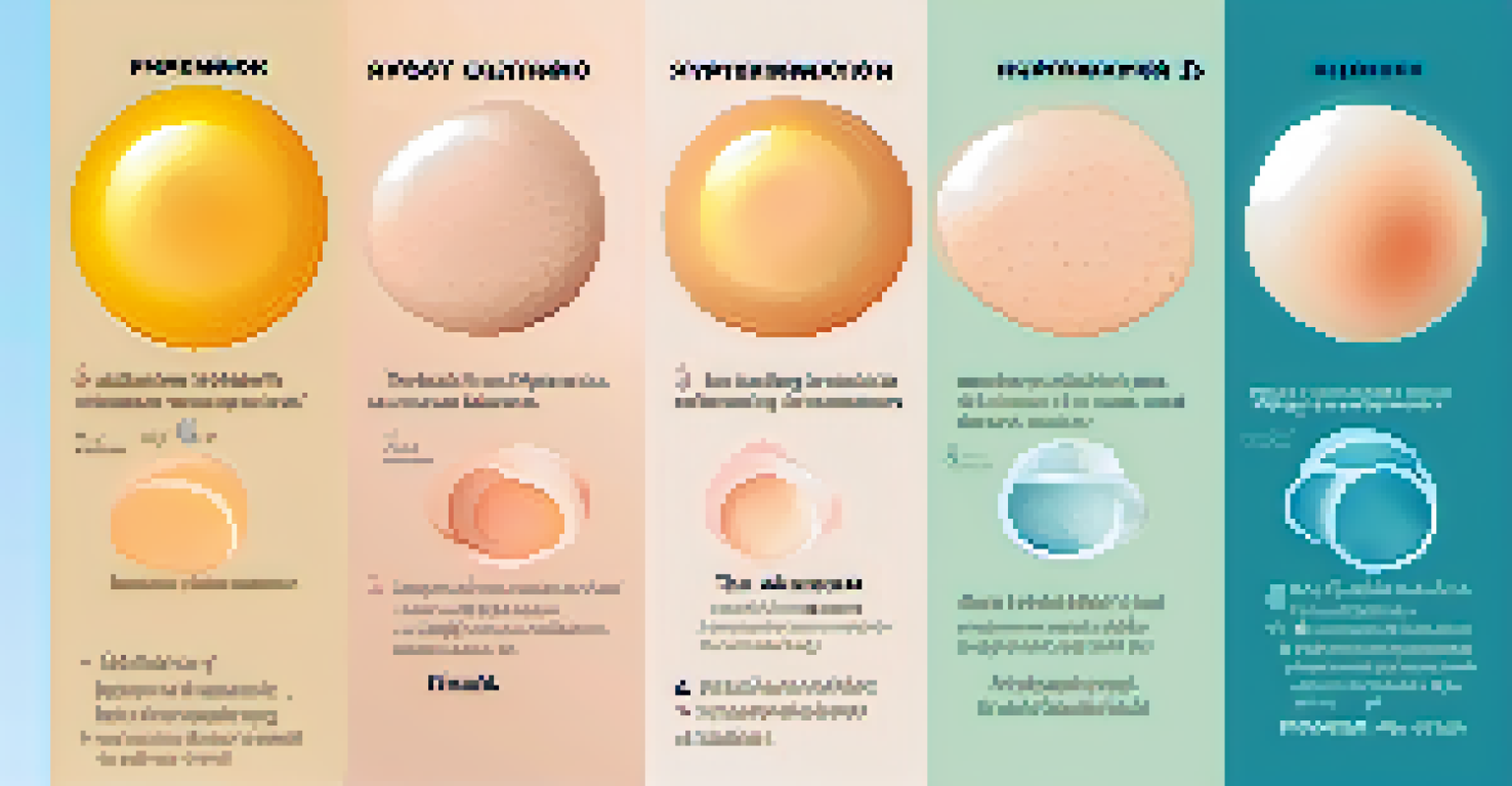Understanding Hyperpigmentation: Causes and Treatment Methods

What is Hyperpigmentation and Why Does it Occur?
Hyperpigmentation is a common skin condition characterized by dark patches or spots on the skin. These spots occur when excess melanin, the pigment that gives skin its color, is produced. It can affect people of all skin types and can appear on any part of the body, though the face and hands are particularly common areas.
The greatest wealth is health.
There are several reasons why hyperpigmentation occurs. Sun exposure is one of the leading culprits, as UV rays can increase melanin production. Other factors include hormonal changes, certain medications, and even inflammation from skin injuries, which can trigger an overproduction of pigment.
Understanding the underlying causes of hyperpigmentation is crucial for effective treatment. By identifying whether it's due to sun exposure, hormonal changes, or other factors, individuals can tailor their approach to managing and reducing these dark spots.
Types of Hyperpigmentation You Should Know About
There are three main types of hyperpigmentation: sun-induced, post-inflammatory, and melasma. Sun-induced hyperpigmentation occurs from prolonged sun exposure, resulting in freckles or age spots. Post-inflammatory hyperpigmentation often follows skin injuries or conditions like acne, leaving dark marks behind.

Melasma, on the other hand, is often triggered by hormonal changes, particularly during pregnancy or with the use of oral contraceptives. It typically appears as symmetrical brown patches on the face, especially on the cheeks and forehead. This type can be particularly stubborn and may require specific treatments.
Understanding Hyperpigmentation
Hyperpigmentation is caused by excess melanin production, leading to dark patches on the skin due to factors like sun exposure, hormonal changes, and inflammation.
Recognizing which type of hyperpigmentation you have can significantly affect your treatment strategy. Each type has unique characteristics, which means that approaches to reduce their appearance may vary based on their specific causes.
Common Causes of Hyperpigmentation Explained
The primary cause of hyperpigmentation is increased melanin production in the skin. This can be triggered by several factors, with sun exposure being the most significant. The sun’s UV rays stimulate melanocytes, the cells responsible for producing melanin, leading to darkening of the skin over time.
Your skin is a reflection of your overall health.
Hormonal changes are another major contributor, especially for women. Conditions like pregnancy or hormonal therapy can lead to melasma, which manifests as dark patches. Additionally, certain medications can also cause increased pigmentation as a side effect.
Lastly, skin injuries or inflammation can result in post-inflammatory hyperpigmentation. This often occurs after acne, eczema, or other skin conditions, causing the skin to darken in the healing process. Understanding these causes is essential for preventing and treating hyperpigmentation effectively.
Preventing Hyperpigmentation: Essential Tips
Prevention is always better than cure, and this holds true for hyperpigmentation. The most effective way to prevent dark spots is by protecting your skin from the sun. Using a broad-spectrum sunscreen with at least SPF 30 daily, even on cloudy days, can significantly reduce the risk of developing sun-induced pigmentation.
Wearing protective clothing and seeking shade during peak sun hours is also crucial. Additionally, avoiding tanning beds and being mindful of sun exposure can further help in keeping your skin even-toned and healthy.
Preventing Dark Spots Effectively
The best way to prevent hyperpigmentation is to protect your skin from the sun by using sunscreen, wearing protective clothing, and being cautious with skin treatments.
Another prevention tip is to be cautious with skin treatments. If you have sensitive skin, harsh chemicals or aggressive exfoliation can lead to inflammation and trigger post-inflammatory hyperpigmentation. Opting for gentle skincare products and treatments can keep your skin safe and minimize risks.
Effective Treatment Options for Hyperpigmentation
When it comes to treating hyperpigmentation, several options are available. Topical treatments containing ingredients like hydroquinone, kojic acid, or vitamin C can help lighten dark spots over time. These products work by inhibiting melanin production and promoting an even skin tone.
In addition to topical treatments, professional procedures can also be effective. Chemical peels, laser therapy, and microdermabrasion are popular methods that can help remove the top layers of skin, reducing the appearance of dark spots. Consulting with a dermatologist can help determine the best option based on individual needs.
It's important to remember that treatment takes time and consistency. While some results may be visible within a few weeks, significant changes often require several months of diligent application of treatments. Patience and perseverance are key to achieving the desired results.
Natural Remedies for Hyperpigmentation: Do They Work?
Many people turn to natural remedies for hyperpigmentation, seeking alternatives to chemical treatments. Ingredients like lemon juice, aloe vera, and turmeric are often touted for their skin-lightening properties. While some of these ingredients have mild effects, their efficacy can vary greatly from person to person.
For instance, lemon juice contains citric acid, which can help exfoliate the skin, but it can also make the skin more sensitive to sunlight. Aloe vera has soothing properties and can aid in healing, while turmeric is known for its anti-inflammatory effects. However, scientific evidence supporting their effectiveness in treating hyperpigmentation is limited.
Treatment Options Available
There are various treatments for hyperpigmentation, including topical solutions and professional procedures, but consistency and patience are crucial for achieving results.
If you choose to use natural remedies, it's essential to approach them with caution. Conduct a patch test to avoid potential allergic reactions and consult with a dermatologist to ensure that you're using safe and effective methods. Sometimes, combining natural remedies with proven treatments can yield the best results.
When to Seek Professional Help for Hyperpigmentation
While many cases of hyperpigmentation can be managed at home, there are times when professional help is necessary. If the dark spots are persistent, worsening, or accompanied by other symptoms, it’s crucial to consult a dermatologist. They can help rule out any underlying conditions that may need medical attention.
Additionally, if over-the-counter treatments are not providing the desired results, a skincare professional can offer alternative solutions. They may recommend prescription-strength treatments or advanced procedures that can effectively address the pigmentation issues.

Lastly, if hyperpigmentation is affecting your self-esteem or mental well-being, seeking professional advice can provide you with a personalized treatment plan. Remember, there’s no shame in asking for help when it comes to your skin health.